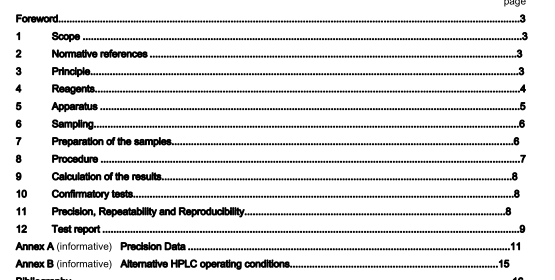BS EN 14185-1:2003 – Non-fatty food — Determination of N-methylcarbamate residues — Part 1: HPLC-method with SPE clean-up

1 Scope This European Standard specifies a high performance liquid chromatographic (HPLC) method for the determination of N-methylcarbamate pesticides in cereals, fruits and vegetables. The method has been validated by collaborative study for carbaryl, carbofuran, methiocarb, methomyl, oxamyl and propoxur parent compounds and for methiocarb sulfoxide in green peppers and apples at levels between 0,08 mg/kg and 0,9 mg/kg. No collaborative data are available for the performance of the method in the determination of other significant metabolites although it is known that the method will not work for oxamyl and methomyl oximes.
2 Normative references This European Standard incorporates, by dated or undated reference, provisions from other publications. These normative references are cited at the appropriate places in the text, and the publications are listed hereafter. For dated references, subsequent amendments to or revisions of any of these publications apply to this European Standard only when incorporated in it by amendment or revision. For undated references the latest edition of the publication referred to applies (including amendments). EN ISO 3696, Water for analytical laboratory use — Specification and test methods (ISO 3696:1987).
3 Principle The sample is homogenized with acetone, dichloromethane and light petroleum and the homogenate is centrifuged to yield two layers of the supernatant. An aliquot portion of the upper layer is evaporated to dryness. Optionally, this extract may be cleaned up by solid phase extraction (SPE) using a cartridge packed with aminopropyl-bonded silica. In the extract solution, the N-methylcarbamates are determined by reversed-phase high performance liquid chromatography (HPLC) with post-column hydrolysis. The methylamine formed is allowed to react with o- phthaldialdehyde and 2-mercaptoethanol and the derivatives are detected with a fluorescence detector. For further information on this method, see [1] to [4].
4 Reagents
4.1 General
Unless otherwise specified, use reagents of recognized analytical grade, preferably for HPLC and pesticide residue analysis, and distilled water for cleaning of glassware or water of at least grade 1 as defined in EN ISO 3696.
Label all standard containers with name and purity of the pesticides. For the full chemical names and structures,see ISO 1750.
4.2 Safety aspects associated with reagents
WARNING — Many pesticides are toxic by various routes of exposure, especially in concentrated form.
When working with these pesticides consult safety data sheets of the manufacturer for information.
Vapours from some volatile solvents are toxic. Several of these solvents are readily absorbed through skin. Use an effective fume hood to remove vapours of these solvents as they are set free.
4.3 Acetone
4.4 Acetic acid
4.5 Dichloromethane
4.6 Light petroleum, boiling range 40 °C to 60 °C
4.7 Methanol
4.8 Acetonitrile
4.9 Solvent mixture
Acetonitrile (4.8) / acetic acid (4.4) 99,9 + 0,1 ( V / V )
4.10 Water, purified by a LC-grade water purification system
4.11 Sodium acetate
4.12 o-Phthaldialdehyde
4.13 Sodium tetraborate, anhydrous
4.14 2-Mercaptoethanol
4.15 Trimethacarb
4.16 Mobile phase A
Acetonitrile (4.8) / water (4.10) 20 + 80 ( V / V ), containing 2,5 mmol/l sodium acetate (4.11). Prior to use, filter the mobile phase A with gentle suction through a membrane filter (5.10).
4.17 Mobile phase B
Methanol (4.7) / water (4.10) 20 + 80 ( V / V ), containing 2,5 mmol/l sodium acetate (4.11). Prior to use, filter the mobile phase B with gentle suction through a membrane filter (5.10).
BS EN 14185-1:2003 – Non-fatty food — Determination of N-methylcarbamate residues — Part 1: HPLC-method with SPE clean-up